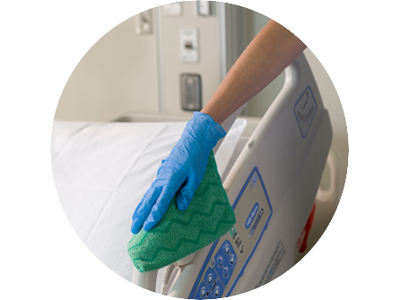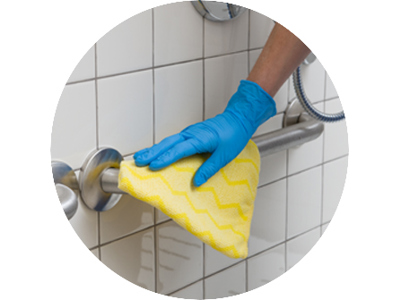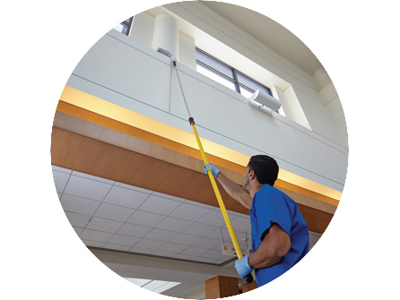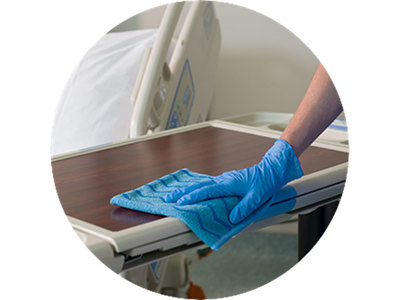Increase cleaning efficacy and the perception of cleanliness with effective and innovative cleaning, material handling, and waste solutions.
VIEW HEALTHCARE RESOURCESPRIORITIES in acute care
BREAK THE CHAIN OF INFECTION WITH PROPER CLEANING PROCEDURES

Either clockwise or counterclockwise, no surface is skipped; this process saves time and is more ergonomic for users.

Cleaning low-touch areas first and high-touch areas last reduces the likelihood of spreading infection and contaminants.

Any dust and debris dislodged from the top surface naturally falls to the lower surfaces.

Circular wiping recontaminates surface areas, while wiping unidirectionally ensures solution is applied to the whole surface.
By using proper cleaning processes and tools, hospitals can maintain a safer environment for patients, visitors, and staff members. Reducing the spread of HAIs (Healthcare-associated infections) is critical to a hospital's bottom line and reputation.
| Item Number | Description |
|---|---|
| FGQ95088YEL | HYGEN™ Microfibre Charging Buckets |
| FGQ90088YEL | HYGEN™ Microfibre Charging Bucket, Press Wringer, Yellow |
| Item Number | Description |
|---|---|
| FG611200YEL | "Caution" Floor Signs |
| 1867507 | "Caution" Executive Series™ Wooden Floor Signs |
| FG9S0900YEL | "Caution" Stable Floor Signs |
| 1867505 | "Caution" Floor Signs |
Keeping tools like safety signs, mops and handles, cleaning solutions and extra paper goods in one, multi-purpose cart helps increase efficiency and limit ergonomic strain. Tidy carts improve a hospital's image to patients, visitors and regulatory bodies.
Learn How to Stock the High-Security Cleaning CartManaging multiple waste streams in a hospital is a key task for EVS technicians. Ranging from traditional waste and recycling in common areas to biohazardous waste in patient rooms, EVS technicians must use proper procedures to safely and efficiently manage waste.
MANAGING HAZARDOUS WASTE IN HEALTHCARE
Washrooms are a hotspot for pathogens in hospitals, so it is critical to have fixtures that promote cleanliness in the space. Touch-free fixtures eliminate key touchpoints in visitor restrooms, leading to a more hygienic experience for guests.
| Item Number | Description |
|---|---|
| FG401310 | OneShot® Lotion Dispensers |
| FG4015411 | OneShot® Lotion Refills |
| FG4015431 | OneShot® Lotion Refills |
| FG401485 | Counter Mount |
| Item Number | Description |
|---|---|
| FG781888LPLAT | Baby Changing Stations |
| FG781988LPLAT | Baby Changing Stations |
| FG781788WHT | Baby Changing Station Liners |
| Item Number | Description |
|---|---|
| FG6141000000 | Waxed Bags for Sanitary Napkin Receptacle |
| RMINIPEDSBF | Sanitary Bins |
| RMINIPEDWF | Sanitary Bins |
Foodservice solutions in hospitals can often be overlooked, but using tools that reduce the risk of cross-contamination and foodborne illness are critical for patient and visitor safety. Having organized kitchens and best-in-class operations can assist in maintaining a clean environment.
| Item Number | Description |
|---|---|
| FG1963000000 | High-Heat Scrapers |
| FG1962000000 | High-Heat Scrapers |
| FG193400WHT | Cold Spoon Spatulas |
| Item Number | Description |
|---|---|
| FG334900GRAY | Bus/Utility Boxes |
| FG335100GRAY | Bus/Utility Boxes |